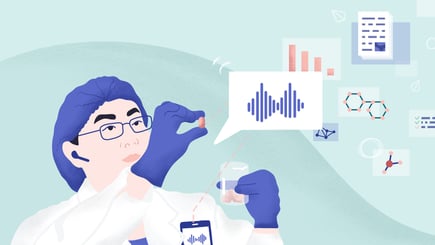
Large language models, also known as LLMs, are advanced machine learning algorithms capable of summarizing, predicting, translating, recognizing, and generating text or other forms of content. These models leverage their extensive knowledge acquired from vast datasets (Lee, 2023). The availability of affordable services with high computing power has facilitated the realization that LLMs can be operated nearly instantaneously. Previously, operating such models necessitated computer software expertise, but that is no longer the case. ChatGPT and similar platforms exemplify how LLMs can now be effortlessly utilized by anyone.
Scientists conducting experiments in the laboratory face numerous challenges, such as locating samples/reagents, understanding experimental procedures, scheduling machine usage, operating unfamiliar equipment, and adhering to safety protocols. These tasks often require them to interrupt their work, remove gloves, and search for relevant information, leading to reduced efficiency. However, with the advent of user-friendly LLMs and hands-free operation platforms, this paradigm is changing.
By leveraging LLMs, scientists can now retrieve information swiftly and accurately without the need for physical interaction. They can access crucial details about sample/reagent locations, experiment procedures, machine availability, operating instructions for new equipment, and safety precautions, all while focusing on their ongoing experiments. This seamless integration of LLMs into the Lab Automation significantly improves overall efficiency.
Moreover, scientists can utilize LLMs to inquire about information they previously obtained by consulting laboratory staff. They can effortlessly ask questions such as "Who was the last person to use the NMR machine?", "When will the confocal microscope be available?", or "Can someone who has used this kit before teach me?". The possibilities for utilizing LLMs in the lab are endless, enabling scientists to ask virtually any query while conducting their experiments, ultimately leading to enhanced efficiency and productivity.
Scientists face the arduous task of returning to their offices after conducting experiments and compiling all the data into comprehensive reports. However, this laborious process can now be simplified with the assistance of trained LLMs, significantly reducing the time spent on report writing.
Trained LLMs can be customized to align with the specific templates commonly used by scientists, ensuring a seamless integration into their reporting workflow. These models can even automatically pre-label the content, facilitating efficient matching with the corresponding template fields. As a result, LLMs cater to the unique reporting requirements of individual scientists, offering a versatile solution.
By leveraging LLMs for report writing, scientists can streamline the entire process and allocate more time to their research. The trained models effectively assist in organizing and presenting experimental data, enabling scientists to generate reports with greater speed and accuracy. Ultimately, the utilization of trained LLMs revolutionizes scientific report writing, enhancing productivity and allowing scientists to focus on their core areas of expertise.
In addition to their other applications, LLMs can prove invaluable for data analysis and interpretation. Scientists can provide these models with past data analysis reports and task them with comparing and summarizing the findings in relation to new datasets. This capability enables the rapid identification and action upon out-of-range data points.
LLMs can serve as trusted companions, offering scientists a valuable "sanity check" tool. By posing precise questions to the model regarding the current dataset, scientists can quickly gain insights and identify patterns almost instantaneously. This real-time interaction with LLMs empowers scientists to extract meaningful information and potential discoveries from their data with greater ease.
By harnessing LLMs for data analysis, scientists benefit from an efficient and reliable resource that enhances their analytical capabilities. These models enable scientists to efficiently flag anomalies, explore data trends, and extract valuable insights in a timely manner. Overall, the utilization of LLMs as a powerful tool for data analysis and interpretation accelerates scientific discovery and facilitates more informed decision-making.

The practical use of LLMs depends significantly on their accessibility. To ensure broad applicability, it is vital to have hardware options that are suitable for laboratory environments. These options include smartphones, tablets, smart glasses, smart speakers, computers, cameras, and microphones commonly found in laboratories. These devices act as the interface between scientists and LLMs, enabling smooth and effortless interaction. Additionally, in certain settings like animal facilities or clean rooms, some of these devices may need to be shared as they cannot leave the designated area. However, in other areas, scientists can utilize their personal devices.
In terms of platforms, it is essential for scientists to have a voice-based interface that enables language-based operation of LLMs. This allows scientists to communicate with the models effortlessly, utilizing natural language without the need for complex commands or interfaces. Moreover, the platform should present answers in a manner that is easily comprehensible, minimizing cognitive load. Scientists should be able to understand the responses without distractions or additional mental effort, ensuring that their focus remains primarily on conducting experiments.
By prioritizing a user-friendly experience, LLM operations can seamlessly integrate into the scientific workflow without causing disruptions. Scientists can engage with LLMs effortlessly, retrieving information, analyzing data, and seeking insights, all while maintaining their primary focus on conducting experiments. Ultimately, the combination of affordable hardware and intuitive platforms empowers scientists to leverage LLMs effectively, enhancing efficiency and productivity in scientific research.
To ensure smooth integration into the scientific workflow, it is essential to prioritize a user-friendly experience when using LLMs. This allows scientists to seamlessly incorporate LLM operations without causing disruptions. Scientists can effortlessly interact with LLMs, retrieving information, analyzing data, and gaining insights, all while maintaining their primary focus on conducting experiments. The combination of affordable hardware and intuitive platforms enables scientists to effectively harness the power of LLMs, leading to increased efficiency and productivity in scientific research. The LabTwin app offers a unique advantage over other interfaces such as computers and early trials of smart glasses. It provides a hands-free, voice-first approach, allowing scientists to carry a digital assistant in their pocket and walk around freely while accessing information and assistance.
LLMs, like any new technology, present both advantages and challenges that operators must carefully consider. It is crucial to acknowledge the ethical risks and inherent limitations associated with these models. While LLMs offer efficient and reliable assistance for specific tasks, they cannot replace human reasoning capabilities. Their role is to augment human abilities rather than replace them.
One important consideration is the potential for LLMs to generate hallucinated or inaccurate answers if not used precisely or if commands are unclear. Another challenge lies in the fact that LLMs may provide different answers to the same question, which can be confusing for scientists relying on them. Therefore, it is essential to exercise caution and not rely solely on LLMs for decision-making. Adopting a "human in the loop" approach is crucial to ensure the safe and responsible use of LLMs.
The establishment of the legal framework for LLMs is still ongoing. Considerations such as copyright infringement, intellectual property protection, and data privacy need to be thoroughly evaluated when choosing LLM models and providers. In industries like drug development and product innovation, where accuracy is critical, scientists cannot afford mistakes. Therefore, it is crucial to use LLMs in a correct and responsible manner. When exploring LLMs, it is essential to seek a partner that can offer a secure environment for leveraging these technologies. LabTwin GmbH prioritizes data security and protection when collaborating with clients.
To leverage LLMs effectively, organizations should define high-impact use cases, conduct diverse user testing, and embrace experimentation for significant returns.
In conclusion, large language models (LLMs) offer valuable support for scientists in various tasks, but ethical considerations and limitations must be navigated. Integration requires attention to legal and privacy aspects, and testing helps understand and adjust their usage. When used responsibly alongside human expertise, LLMs can enhance scientific research and drive efficiency to new heights..
At LabTwin, we have been at the forefront of exploring and harnessing the potential of LLMs to meet the unique needs of scientists. We are dedicated to ensuring that LLMs are utilized effectively and responsibly in scientific research and development. (OpenAI, OpenAI, 2023)
If you would like to learn more about our work and how LLMs can benefit your organization, please don't hesitate to reach us out or book a demo or Watch a video of LabTwin in action . We are here to provide further information and assist you in leveraging the power of LLMs in your scientific endeavors.
Lee, A. (2023, 1 26). What Are Large Language Models Used For? Retrieved from NIVIDA: https://blogs.nvidia.com/blog/2023/01/26/what-are-large-language-models-used-for/
LabTwin. (2023). Retrieved from https://www.labtwin.com/
OpenAI. (2023, June). Retrieved from OpenAI: https://openai.com/blog/insights-from-global-conversations
OpenAI. (2023, March). GPT-4 Technical Report. Retrieved from Cornell University, arxiv: https://arxiv.org/abs/2303.08774
Birhane, A. K. (2023, May). Nature. Retrieved from https://www.nature.com/articles/s42254-023-00581-4

%20(1)-1.png?width=164&height=164&name=Ellipse%2052%20(Stroke)%20(1)-1.png)